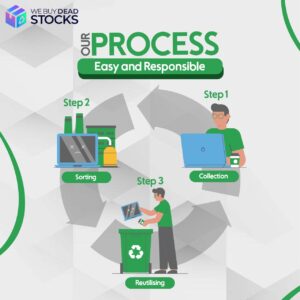Does your storeroom resemble a product graveyard, overflowing with slow-moving or non-existent sales items? You’re not alone. Every business owner faces the challenge of obsolete inventory. But fear not! This blog post will equip you with powerful strategies to tackle these product roadblocks. We’ll delve into non-moving surplus buyers in the UAE, from creative marketing tactics to strategic discounting. Get ready to transform those dusty shelves into profit generators!
Identifying Slow-Moving or Non-Moving Products 🤔
Do you ever feel like some items in your shop have become permanent residents? Those might be slow-moving definitions of the products – things just sitting there, not flying off the shelves. They take up valuable space and tie up your money, so it’s important to identify them before they become a bigger issue.
Here’s a toolbox full of ways to find those slow-movers:
- Sales Sleuthing: Your sales data is a treasure trove of information. Run reports to see which items rarely appear on customer receipts. These hidden gems (or should we say hidden bricks?) could be your slow-movers. For that you would have to reach out to non-moving surplus buyers in the UAE.
- Turnover Time Test: Imagine how long it takes to sell all your stock of a particular item. This “turnover time” helps identify slow-movers. If it takes ages to sell something, it’s a sign it might be sticking around too long.
- Inventory Inspection: Think of this like cleaning out your closet, but for your store. Regularly check your stock – every shelf, every corner. Are there forgotten things lurking in the shadows? Time to give them a fresh look (or maybe a new home!).
Why are regular obsolete inventory audits so important? They help you avoid a cluttered stockroom, just like cleaning your closet helps you avoid a messy room. Regular checks free up space for things that will sell better, which in turn keeps your cash flowing and your store looking sharp.
Remember, slow-movers can be sneaky! By using sales data, checking turnover times, and doing frequent inventory audits through deadstock buyers in the UAE, you’ll be able to spot them before they become a bigger problem. This way, you can keep your stock fresh and your business thriving!
Causes of Reaching Non-moving Surplus Buyers For Non-Moving Products 📉
We talked about those slow-movers and non-moving surplus buyers , but what makes a product unpopular in the first place? Several things can cause items to gather dust:
- Changing Tastes: What’s hot today might be out tomorrow. If consumer preferences shift and your product doesn’t keep up, it can become outdated fast. Think fidget spinners – super popular one minute, forgotten the next!
- Seasonal Swings: Some products are seasonal hits, like beach umbrellas in summer or cozy scarves in winter. If you’re stuck with a bunch of off-season items, they’ll likely move slowly until the right time comes around.
- Overstocking Oops: Ever buy way too much of something? Stores and do it too! If you order too much stock, you’ll end up with a pile of the same item nobody needs. This can make it hard to sell anything especially to non-moving surplus buyers in the UAE.
- Marketing Misfires: Great products need great marketing! If no one knows about your amazing item, it won’t sell. Poor marketing or a lack of promotion can leave even the best product stuck on the shelf.
Dead Stock Dilemma: 📦
These are the worst-case scenario slow-movers – products that have zero chance of ever selling. Expired foods, outdated electronics, or damaged goods all fall into this category. They’re just taking up space and costing you money.
The UAE Solution:
If you’re stuck with a mountain of slow-movers , there are companies called non-moving surplus buyers or dead stock buyers that specialize in taking unwanted inventory off your hands. They often buy in bulk at a discounted price.
Closing Inventory Countdown:
When it’s time to take stock of your inventory (the calculation of closing inventory at the end of a period), slow-movers can bring down your numbers. They’re technically assets (things you own), but they’re not generating any sales. This can make your business look less profitable.
By understanding these reasons, you can be more strategic about what you stock and how you sell it to non-moving surplus buyers or dead stock buyers in UAE. Remember, keeping an eye on trends, avoiding overstocking, and having a solid marketing plan can help prevent slow-movers from becoming a problem in the first place.
Customer Feedback & Market Research 💯
We’ve talked about finding slow-moving definitions and the reasons why they might be stuck on your shelves, but there’s another key tool to help you avoid them in the first place: customer feedback.
Your customers are like a treasure chest of information! By listening to what they have to say, you can understand how your products are performing and what you can do to improve.
- Feedback Focus Groups: Gather a small group of customers and chat about your products. Inquire about their preferences, dislikes, and areas they would like to alter. Their honest opinions can be a goldmine!
- Surveys on the Fly: Quick online surveys after a purchase can give you instant feedback. Ask simple questions about the product and how likely the customer is to recommend it.
- Social Media Buzz: People love to talk about their experiences online! See what customers are saying about your products on social media. Positive comments are great, but negative ones can be even more valuable – they point out areas for improvement.
Feedback for the Future:
The information you gather from customer feedback can be a game-changer. Here’s how to get calculation of closing inventory:
- Product Tweaks: Maybe your headphones are comfy but the sound quality isn’t great. Customer feedback can help you identify areas for improvement and make adjustments to future versions.
- Marketing Magic: Feedback can also help you understand how to market your products better. If customers find your yoga mats confusing to use, you can create clearer instructions or marketing materials.
Market Research Matters
Customer feedback isn’t the only way to get insights. Market research helps you understand what’s popular in the bigger picture. By looking at trends and what other businesses are doing, you can avoid stocking outdated items and keep your offerings fresh and relevant.
The Final Tally: Keeping Your Stock Moving Smoothly 🚀
Slow-moving products can be a drag on any business. But by using the tips in this blog, you can spot them before they become a problem. Regular obsolete inventory checks, sales data analysis, and understanding common slow-mover causes will keep you ahead of the game.
Remember, your customers are your best allies! Listen to their feedback and use market research to understand what’s trending. This valuable information can help you tweak products, improve marketing strategies, and ensure you’re stocking what people actually want to buy.
So, keep your inventory lean and mean, listen to your customers, and stay on top of trends. By following these steps, you can turn your stockroom into a haven of fast-moving products and a recipe for business success!





